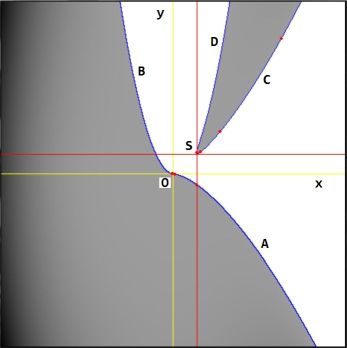
The basic equation is defined here for real $(x,y)$ as well, by:
$$
x^2 y^2 = 4 x^5 + y^3
$$
See picture ; window $-200 < x < +200$ , $-4000 < y < +4000$ .
It is immediately clear that $(x,y) = (0,0)$ is an (integer)
solution of the equation and that $x = 0 \leftrightarrow y = 0$ .
$\color{red}{Tangents}\,$ at the curve are calculated by implicit differentation:
$$
2 x y^2 + x^2 2 y y' = 20 x^4 + 3 y^2 y' \quad \Longrightarrow \quad
y' = \frac{20 x^4 - 2 x y^2}{2 y x^2 - 3 y^2}
$$
Horizontal tangents at:
$$
20 x^4 - 2 x y^2 = 0 \quad \Longrightarrow \quad y^2 = 10 x^3
$$
Substitute into the basic equation to obtain:
$$
x^2 y^2 = 4 x^5 + y^3 \quad \Longrightarrow \quad
x^2 \cdot 10 x^3 = 4 x^5 + 10 x^3 y
$$
We have covered the trivial solution $(0,0)$ so forget about it in the sequel.
$$
6 x^2 = 10 y \quad \Longrightarrow \quad 36 x^4 = 100 y^2 = 1000 x^3
\quad \Longrightarrow \quad (x_S,y_S) = \left(\frac{10^3}{6^2},\sqrt{\frac{10^{10}}{6^6}}\right)
$$
The Special point S is important for the numerical work
that follows. Vertical tangents at:
$$
2 y x^2 - 3 y^2 = 0 \quad \Longrightarrow \quad y = \frac{2}{3} x^2
$$
Substitute into the basic equation to obtain:
$$
x^2 \cdot \frac{4}{9} x^4 = 4 x^5 + \frac{8}{27} x^6
\quad \Longrightarrow \quad \frac{4}{27} x = 4
\quad \Longrightarrow \quad (x,y) = (27,486)
$$
The latter happens to be one of the required integer solutions !
The rest of the method is brute force.
It is clear from the picture that there are four branches:
program krabbel;
function pow(x : double; n : integer) : double; var q : double; k : integer; begin q := 1; for k := 1 to n do q := q * x; pow := q; end;
function f(x,y : double) : double; begin f := pow(x,2)*pow(y,2) - (4*pow(x,5) + pow(y,3)); end;
procedure crawl_A; var x,y : integer; g : double; begin x := 0; y := 0; while true do begin y := y - 1; g := f(x,y); if g = 0 then Writeln(x,' ',y); while g > 0 do begin x := x + 1; g := f(x,y); if g = 0 then Writeln(x,' ',y); end; end; end;
procedure crawl_B; var x,y : integer; g : double; begin x := 0; y := 0; while true do begin y := y + 1; g := f(x,y); if g = 0 then Writeln(x,' ',y); while g < 0 do begin x := x - 1; g := f(x,y); if g = 0 then Writeln(x,' ',y); end; end; end;
procedure crawl_C; var x,y : integer; g : double; begin x := Round(pow(10,3)/pow(6,2)); y := Round(sqrt(pow(10,10)/pow(6,6))); while true do begin y := y + 1; g := f(x,y); if g = 0 then Writeln(x,' ',y); while g > 0 do begin x := x + 1; g := f(x,y); if g = 0 then Writeln(x,' ',y); end; end; end;
procedure crawl_D; var x,y : integer; g : double; begin x := 27; y := 486; while true do begin y := y + 1; g := f(x,y); if g = 0 then Writeln(x,' ',y); while g < 0 do begin x := x + 1; g := f(x,y); if g = 0 then Writeln(x,' ',y); end; end; end;
begin { crawl_A; crawl_B; } crawl_C; { crawl_D; } end.
by hand: 0 0 27 486
crawl_A: 2 -4 27 -243
crawl_B: -1 2
crawl_C: 32 512 54 972 125 3125
crawl_D: nothing